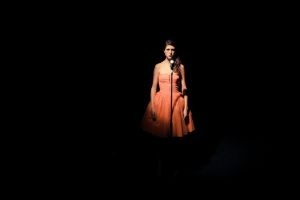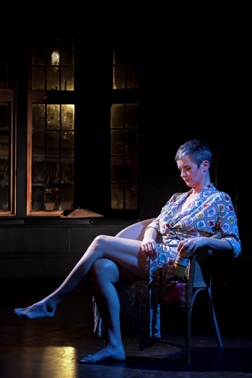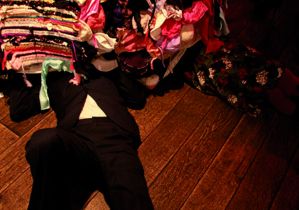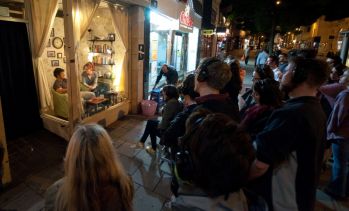theartsdesk in Brighton: At the Festival Where Anything Goes | reviews, news & interviews
theartsdesk in Brighton: At the Festival Where Anything Goes
theartsdesk in Brighton: At the Festival Where Anything Goes
Aung San Suu Kyi made freedom of expression this year's theme
Persecuted Burmese freedom fighter Aung San Suu Kyi may be this year’s guest director, provoking a loose theme of "freedom of expression, liberty, and the power of the individual voice" that’s all the more powerful for her enforced absence. But a week in to the 2011 Brighton Festival and Brighton Festival Fringe, I’d say it’s the stewards who are this year’s under-sung heroes and heroines. As the craze for interactive performance burgeons, the tricky task is falling to them of reassuring wary audiences without giving the creative game away. Would there be room for a rucksack in Small Space? Would the Minotaur-themed edible narrative be suitable for vegetarians? And what would happen if the polite woman with the nervous laugh decided she’d rather not touch the performer of An Appreciation’s genitals? (She did, in the end, but more of that later…)
While Kyi’s remote involvement inspired a righteous opening salvo – a concert performance of Beethoven’s prison opera Fidelio hot on the heels of Asian Dub Foundation’s dhol-pounding rap-rock politics – many of my most memorable moments so far have simply come from watching other audience members. The middle-aged woman with the heavy shopping bag, for instance, who seemed unable to tear herself away from Lynette Wallworth’s survivor-themed video installation Evolution of Fearlessness (you summon a succession of eloquently silent female figures from the darkness by touching your hand to a screen). The young man dreamily cycling through Kutluğ Ataman’s Mesopotamian Dramaturgies, a commission for the vast derelict cavern of a former fruit and veg market. The family who’d brought their baby in a cot to Jardin Flambeau, a stunning outdoor installation from French company Compagnie Carabosse. Every inch of St Ann’s Well Gardens was set ablaze with flaming cascades of flower pots and mechanical fire sculptures and, for two joyous nights, no one seemed to give a merde about health and safety.
The same could be said of Australian company Circa, whose dance-circus is as breathtaking for its 21st-century beauty as its daring acrobatics, leading to the most standing ovations of the Festival so far. (The show, also called Circa, finished its five-day run last night, but returns to the UK for one night only on 21 May as part of the Salisbury Festival.) The four men and three women also have zero time for the polarised gender aesthetic pandered to by so many of their peers – which is to say that at one (by no means atypical) point, a small red-headed woman balanced a bloke on her head. (Circa pictured below.)
 Beginning like Danny Boyle’s Frankenstein, with a half-naked man jerking and writhing in a spotlight, Circa never lost that fresh apprehension of the human body – its awkwardnesses and limitations as well as its grace and strength. Sometimes the focus narrowed to a single, sickeningly bowing finger joint, at others the choreography rolled out across the stage with a sudden sweep of sound and light and leaping bodies. Meanwhile violins strained exquisitely like tendons, beats shuddered like punished muscle and, in the most talked-about routine in the Theatre Royal toilet queue, a woman in red stilettos used a man’s torso as a climbing frame to Leonard Cohen’s "Came So Far For Beauty". (The heel tracks were clearly visible at the curtain call, leaving us to wonder whether the ambulance lingering outside the theatre before the performance was standard issue.)
Beginning like Danny Boyle’s Frankenstein, with a half-naked man jerking and writhing in a spotlight, Circa never lost that fresh apprehension of the human body – its awkwardnesses and limitations as well as its grace and strength. Sometimes the focus narrowed to a single, sickeningly bowing finger joint, at others the choreography rolled out across the stage with a sudden sweep of sound and light and leaping bodies. Meanwhile violins strained exquisitely like tendons, beats shuddered like punished muscle and, in the most talked-about routine in the Theatre Royal toilet queue, a woman in red stilettos used a man’s torso as a climbing frame to Leonard Cohen’s "Came So Far For Beauty". (The heel tracks were clearly visible at the curtain call, leaving us to wonder whether the ambulance lingering outside the theatre before the performance was standard issue.)  Those who missed it back in 2007 have been fighting for tickets to the revival of The New World Order, a staging of Harold Pinter’s political shorts in Brighton Town Hall by local company Hydrocracker. I did catch it the first time round (and still have nightmares about listening to someone pretending to be raped while a member of the audience loudly unwrapped a bar of Green & Blacks). So I was free to pursue my chills on the Fringe instead, and caught a theatrical falling star in the form of Theatre Ad Infinitum’s captivating piece of sung theatre, The Big Smoke. The story of a talented yet troubled young Canadian artist inspired by the lives and works of Sylvia Plath and Virginia Woolf, it’s the sort of thing that would normally make me buy a ticket for the Ladyboys of Bangkok. But I was pinned to my seat by Amy Nostbakken’s a cappella performance (pictured above), in which each scored phrase summoned a character or place, or rung an intense new note of feeling, and the writing grew ever more controlled as the young woman’s psychosis spiralled. A brave and devastatingly effective form, if not entirely new – I kept thinking of Ophelia’s madness, which is so often enacted in fractured song.
Those who missed it back in 2007 have been fighting for tickets to the revival of The New World Order, a staging of Harold Pinter’s political shorts in Brighton Town Hall by local company Hydrocracker. I did catch it the first time round (and still have nightmares about listening to someone pretending to be raped while a member of the audience loudly unwrapped a bar of Green & Blacks). So I was free to pursue my chills on the Fringe instead, and caught a theatrical falling star in the form of Theatre Ad Infinitum’s captivating piece of sung theatre, The Big Smoke. The story of a talented yet troubled young Canadian artist inspired by the lives and works of Sylvia Plath and Virginia Woolf, it’s the sort of thing that would normally make me buy a ticket for the Ladyboys of Bangkok. But I was pinned to my seat by Amy Nostbakken’s a cappella performance (pictured above), in which each scored phrase summoned a character or place, or rung an intense new note of feeling, and the writing grew ever more controlled as the young woman’s psychosis spiralled. A brave and devastatingly effective form, if not entirely new – I kept thinking of Ophelia’s madness, which is so often enacted in fractured song.
 Equally brave is Sue Maclaine’s Still Life: An Audience with Henrietta Moraes (pictured left), performed stark naked to the sporadic sounds of sweeping charcoal and scratching pencil. Running in a life-drawing studio at the Phoenix Gallery until 28 May as part of the HOUSE Festival, this striking monologue takes the form of an art class as Moraes – Fifties bohemian and model and muse to Francis Bacon, Lucian Freud and Maggi Hambling – punctuates her frank reminiscences by recreating several of her most famous poses. The audience’s drawings, from the pro to the piss-poor, are all being pinned up in the gallery as the run progresses, giving Still Life… an approximation of that permanence which visual art lauds and theatre partly defines itself by lacking. But, as each set of drawings will necessarily vary as much as each audience, I guess it could just prove to be a neat celebration of theatre’s transience, too.
Equally brave is Sue Maclaine’s Still Life: An Audience with Henrietta Moraes (pictured left), performed stark naked to the sporadic sounds of sweeping charcoal and scratching pencil. Running in a life-drawing studio at the Phoenix Gallery until 28 May as part of the HOUSE Festival, this striking monologue takes the form of an art class as Moraes – Fifties bohemian and model and muse to Francis Bacon, Lucian Freud and Maggi Hambling – punctuates her frank reminiscences by recreating several of her most famous poses. The audience’s drawings, from the pro to the piss-poor, are all being pinned up in the gallery as the run progresses, giving Still Life… an approximation of that permanence which visual art lauds and theatre partly defines itself by lacking. But, as each set of drawings will necessarily vary as much as each audience, I guess it could just prove to be a neat celebration of theatre’s transience, too.
Brian Lobel was also accumulating a record of his short but surprisingly sweet show, An Appreciation. One of five performances in the Festival’s boundary-pushing 5x5 (Loud & Clear) event, it involved him inviting each of the five audience members in turn to physically "appreciate" his genitals, before summing up their impressions in marker pen on pieces of card. Cards from previous shows were piling up on the floor, testifying to both Brighton’s game attitude and Lobel’s thoughtful approach to the subject of self-acceptance. This wasn’t the only theatre-going first afforded to me by 5x5 (Loud & Clear): I thought site-specific theatre had gone pretty much everywhere until, for the purposes of Smalls (pictured below), I was invited to crawl under performance and installation artist Jenny Edbrooke’s skirt. Elsewhere those sick of site-specific might have been amused by Seth Kriebel’s gaming-inspired The Unbuilt Room, a piece of promenade theatre you undertake without lifting a finger, or even leaving your seat. Generally speaking, the Brighton Festival audience seems prepared to go with pretty much anything this year – except complacency. Which is why the only real misfires thus far have resulted from a spot of lazy booking in the Books & Debate programme. A discussion on protest songs between music journalist Dorian Lynskey (author of a new history of the subject, 33 Revolutions per Minute) and Billy Bragg suffered from the lack of a younger generation’s perspective. Bragg was predictably authoritative, angry and entertaining, insisting that Live Aid would never have happened without the miner’s strike (all those musicians looking to assuage their guilt, with the exception of Paul Weller, at having done nothing) and pointing out that protest songs are on the wane because pop music is no longer "the only language that young people have to communicate with each other in". But was booking a rapper or grime MC really out of the question?
Generally speaking, the Brighton Festival audience seems prepared to go with pretty much anything this year – except complacency. Which is why the only real misfires thus far have resulted from a spot of lazy booking in the Books & Debate programme. A discussion on protest songs between music journalist Dorian Lynskey (author of a new history of the subject, 33 Revolutions per Minute) and Billy Bragg suffered from the lack of a younger generation’s perspective. Bragg was predictably authoritative, angry and entertaining, insisting that Live Aid would never have happened without the miner’s strike (all those musicians looking to assuage their guilt, with the exception of Paul Weller, at having done nothing) and pointing out that protest songs are on the wane because pop music is no longer "the only language that young people have to communicate with each other in". But was booking a rapper or grime MC really out of the question?
A Live Trail took an intrepid six at a time to see dance in a toilet
The substitution of chummy chat for debate worsened with "The Pleasures and Politics of Food", an Observer Food Monthly debate hosted by their columnist Jay Rayner and featuring its editor Allan Jenkins. "Last best meal" anecdotes of private helicopters and suckling pigs were patiently borne by an audience who, when it came to the Q&A, wanted to know how residents of Brighton’s Whitehawk and Moulsecoomb estates could be encouraged to eat less processed food. Clearly the woman from Brighton & Hove Food Partnership should have been on the panel, not queuing for the mike. Afterwards, as Rayner and pals hurried towards the station and their train back to London, only one of the group could be spotted popping his head behind the fence where an unmissable sign reads "The Mound: save our Community Garden". Shame they’d only found time for drinks at Italian chain café Carluccio's beforehand.
 Thankfully the spirit of enquiry is alive and well in the audience at least. Perhaps taking its cue from the huge success last year of Before I Sleep, staged in a disused department store, the Fringe has twigged that window shopping can work just as well for theatre as for consumer goods. Front, a domestic duet staged at night in the windows of an Oxfam shop (pictured above; image by Paul Kondritz) and watched from the outside with the aid of headphones, kept picking up variously sober passers-by as the performance progressed. A barber’s window, meanwhile, was just one of eight locations used by Nightingale Theatre’s super-playful A Live Trail , which took an intrepid six at a time to see dance in a toilet, participate in a secret meeting beneath a shoemaker's shop, and queue for a final piece called Quintessentially British in which the queuing turned out to be the main event.
Thankfully the spirit of enquiry is alive and well in the audience at least. Perhaps taking its cue from the huge success last year of Before I Sleep, staged in a disused department store, the Fringe has twigged that window shopping can work just as well for theatre as for consumer goods. Front, a domestic duet staged at night in the windows of an Oxfam shop (pictured above; image by Paul Kondritz) and watched from the outside with the aid of headphones, kept picking up variously sober passers-by as the performance progressed. A barber’s window, meanwhile, was just one of eight locations used by Nightingale Theatre’s super-playful A Live Trail , which took an intrepid six at a time to see dance in a toilet, participate in a secret meeting beneath a shoemaker's shop, and queue for a final piece called Quintessentially British in which the queuing turned out to be the main event.  One section involved us sitting blindfold in a stranger’s sitting room while four wordless voices circled and closed in, a deeply sensual experience that affected me more like a massage than an art performance. Then it was our turn to make noises – mostly mortified groans – as we were led out into the street and through Brighton’s bustling North Laine, still blindfolded, crocodile fashion, and with plums in our mouths (pictured above: author fourth from right). "Is this some kind of submission thing?" asked a passer-by. Nah, just day one of the Brighton Fringe.
One section involved us sitting blindfold in a stranger’s sitting room while four wordless voices circled and closed in, a deeply sensual experience that affected me more like a massage than an art performance. Then it was our turn to make noises – mostly mortified groans – as we were led out into the street and through Brighton’s bustling North Laine, still blindfolded, crocodile fashion, and with plums in our mouths (pictured above: author fourth from right). "Is this some kind of submission thing?" asked a passer-by. Nah, just day one of the Brighton Fringe.
more Theatre
 Machinal, The Old Vic review - note-perfect pity and terror
Sophie Treadwell's 1928 hard hitter gets full musical and choreographic treatment
Machinal, The Old Vic review - note-perfect pity and terror
Sophie Treadwell's 1928 hard hitter gets full musical and choreographic treatment
 An Actor Convalescing in Devon, Hampstead Theatre review - old school actor tells old school stories
Fact emerges skilfully repackaged as fiction in an affecting solo show by Richard Nelson
An Actor Convalescing in Devon, Hampstead Theatre review - old school actor tells old school stories
Fact emerges skilfully repackaged as fiction in an affecting solo show by Richard Nelson
 The Comeuppance, Almeida Theatre review - remembering high-school high jinks
Latest from American penman Branden Jacobs-Jenkins is less than the sum of its parts
The Comeuppance, Almeida Theatre review - remembering high-school high jinks
Latest from American penman Branden Jacobs-Jenkins is less than the sum of its parts
 Richard, My Richard, Theatre Royal Bury St Edmund's review - too much history, not enough drama
Philippa Gregory’s first play tries to exonerate Richard III, with mixed results
Richard, My Richard, Theatre Royal Bury St Edmund's review - too much history, not enough drama
Philippa Gregory’s first play tries to exonerate Richard III, with mixed results
 Player Kings, Noel Coward Theatre review - inventive showcase for a peerless theatrical knight
Ian McKellen's Falstaff thrives in Robert Icke's entertaining remix of the Henry IV plays
Player Kings, Noel Coward Theatre review - inventive showcase for a peerless theatrical knight
Ian McKellen's Falstaff thrives in Robert Icke's entertaining remix of the Henry IV plays
 Cassie and the Lights, Southwark Playhouse review - powerful, affecting, beautifully acted tale of three sisters in care
Heart-rending chronicle of difficult, damaged lives that refuses to provide glib answers
Cassie and the Lights, Southwark Playhouse review - powerful, affecting, beautifully acted tale of three sisters in care
Heart-rending chronicle of difficult, damaged lives that refuses to provide glib answers
 Gunter, Royal Court review - jolly tale of witchcraft and misogyny
A five-women team spell out a feminist message with humour and strong singing
Gunter, Royal Court review - jolly tale of witchcraft and misogyny
A five-women team spell out a feminist message with humour and strong singing
 First Person: actor Paul Jesson on survival, strength, and the healing potential of art
Olivier Award-winner explains how Richard Nelson came to write a solo play for him
First Person: actor Paul Jesson on survival, strength, and the healing potential of art
Olivier Award-winner explains how Richard Nelson came to write a solo play for him
 Underdog: the Other, Other Brontë, National Theatre review - enjoyably comic if caricatured sibling rivalry
Gemma Whelan discovers a mean streak under Charlotte's respectable bonnet
Underdog: the Other, Other Brontë, National Theatre review - enjoyably comic if caricatured sibling rivalry
Gemma Whelan discovers a mean streak under Charlotte's respectable bonnet
 Long Day's Journey Into Night, Wyndham's Theatre review - O'Neill masterwork is once again driven by its Mary
Patricia Clarkson powers the latest iteration of this great, grievous American drama
Long Day's Journey Into Night, Wyndham's Theatre review - O'Neill masterwork is once again driven by its Mary
Patricia Clarkson powers the latest iteration of this great, grievous American drama
 Opening Night, Gielgud Theatre review - brave, yes, but also misguided and bizarre
Sheridan Smith gives it her all against near-impossible odds
Opening Night, Gielgud Theatre review - brave, yes, but also misguided and bizarre
Sheridan Smith gives it her all against near-impossible odds
 The Divine Mrs S, Hampstead Theatre review - Rachael Stirling shines in hit-and-miss comedy
Awkward mix of knockabout laughs, heartfelt tribute and feminist messaging never quite settles
The Divine Mrs S, Hampstead Theatre review - Rachael Stirling shines in hit-and-miss comedy
Awkward mix of knockabout laughs, heartfelt tribute and feminist messaging never quite settles

Add comment